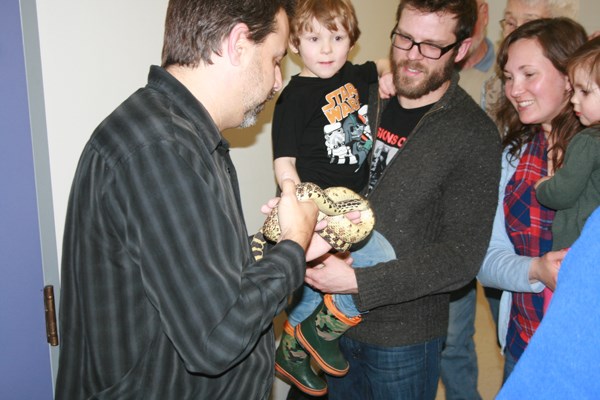Snakes elicit emotion in people, most reacting negatively.
“Why is it that we fear these snakes?” questioned Ray Poulin with the Royal Saskatchewan Museum in Regina.
In answer to his own question, Poulin told those listening to his Earth Day presentation Saturday in Yorkton, an event hosted by the Yellowhead Flyway Birding Trail Association that is very much a learned response.
Poulin, who is the man behind a live display of Saskatchewan snakes at the RSM, said when he takes a live snake out with a group of youngsters, most are curious and want a closer look.
Adults are much more fearful.
“So it’s not an innate fear,” said Poulin.
Poulin flashed a slide of a common garter snake and a fluffy bunny rabbit, noting if you were to pick them up, the rabbit was much more likely to bite than is the snake.
In that regard Poulin said “knowledge is power,” and as people learn more about snakes they will learn they are not to be feared.
That was the reason for the snake show which began last year, and will be in place until the May long weekend.
Snakes Alive, is a temporary exhibit at the Royal Saskatchewan Museum (RSM), featuring all nine species of snakes naturally found in Saskatchewan. The focus of this live exhibit is to entertain and inspire a deeper understanding of nature by featuring the intricate beauty of wildlife found right in our own province.
Poulin admitted they were uncertain if the display might keep people away, but that was not the case.
The largest crowds since 1996, 140,000 people, attended the show in 2016.
The species in the RSM show are rather diverse.
One of the smallest species is the northern red-bellied snake that grows to only about 11-inches said Poulin.
There is the smooth green snake “often called a grass snake,” explained Poulin.
“They tend to be common where they are found,” he added, an area which includes the Qu’Appelle Valley to Lumsden.
The eastern yellow-bellied racer, is a very active snake, said Poulin, noting it will actually chase down grasshoppers to feed.
The racer is one snake which has a bad temperament when handled, but Poulin noted it is not a venomous snake.
There is only one snake which resides naturally in Saskatchewan whose bite is at least somewhat dangerous and that is the prairie rattlesnake.
As a rattlesnake they actual signal when they feel threatened providing anyone close by to back away.
“If rattlesnakes were mean and dangerous they’d sneak up on you,” said Poulin.
Rattlesnakes attack for one of two reasons, food, which they do not see humans as, or to defend itself.
Then there is the bull snake.
“Bull snakes are the largest species of snake we have in Canada,” said Poulin, adding they have been reported up to eight-feet in length.
Other native species include the western hognose, the red-sided garter snake, the wandering garter snake, and the plains garter snake.
The RSM, located at 2445 Albert Street, is open daily from 9:30 a.m. until 5 p.m. Visit www.royalsaskmuseum.ca or call 306-787-2815. Admission is by donation.



